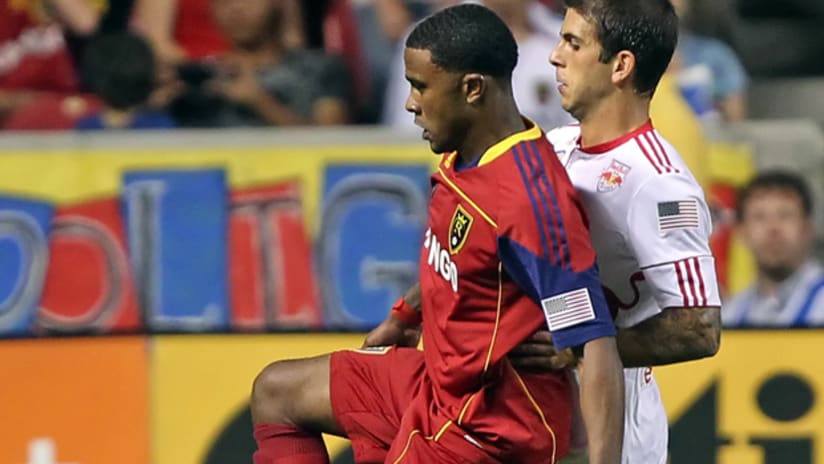Saturday’s 4 pm ET match-up between the New York Red Bulls and defending MLS Cup champs Real Salt Lake isn’t just a clash of two teams in the hunt for the Supporters' Shield. Or two teams fighting for homefield advantage in the playoffs. Or the two best defenses in MLS since June.
Saturday’s match-up is a clash of cultures and styles, both on and off the field.
On the field, Real Salt Lake have replaced Houston and New England as the MLS poster-children for the “Consistency Breeds Success” ethos. Jason Kreis’s team has honed the style he installed back in May 2007 to the point that, for most of the squad, roles and responsibilities are second-nature. That’s a level of understanding and familiarity all managers strive for.
The centerpiece of RSL is defensive midfielder Kyle Beckerman, who compliments his hard-man work with a fair bit of playmaking, including the assist on Fabian Espindola’s winner the last time the two teams met. That flexibility is a hallmark of what RSL does in their midfield.
While Beckerman tends to hold deep in what is nominally a 4-1-2-1-2 “diamond” midfield, that doesn’t mean he’s static. Whichever wingers happen to be playing -- be it Will Johnson, Ned Grabavoy, Andy Williams or Nelson Gonzalez -- are encouraged to pinch inside as opportunities present themselves, temporarily relieving Beckerman of defensive responsibilities as well as providing an avenue for RSL’s fullbacks to push up the flank in support of the attack.
[inlinenode:318477]The other pillar of RSL’s success is midfielder Javier Morales, nominally the point of the diamond. Morales almost always stays high and tries to occupy the channel between the opposing defensive midfield and back line, and will frequently drift slowly across the field in an effort to hide himself from traditional zonal defensive schemes. That puts the burden on other midfielders to maintain possession, but as RSL’s record shows, it’s a burden they can handle.
New York has also played a 4-4-2 for most of the season, but changes are afoot at Red Bull Arena. The arrival of Medhi Ballouchy -- ironically, the player RSL gave up in 2007 to acquire Beckerman -- has led manager Hans Backe to experiment with several different lineups over the past month.
There was the 4-5-1 at Dallas and Los Angeles. There was the diamond with Ballouchy at the point last week against Kansas City. There’s even been a sprinkling of 4-3-3.
The departure from what’s worked throughout the year -- Backe’s team played a 4-4-2 with a flat-4 midfield almost from day one -- has offered mixed results. The Red Bulls are 6-2-2 in their last 10 games, but even the staunchest fans will admit that several of those results have come courtesy of Bouna Coundoul's stellar form in goal.
[inlinenode:318559]In the midst of the upheaval (however light by New York standards), the one unadulterated positive has been the dynamism of the Red Bulls’ flank play. Moving Joel Lindpere to left midfield and the renaissance of Dane Richards -- who will miss the game because of international duty with Jamaica -- means RBNY are capable of attacking down either side of the pitch in a way they haven’t been since 2008 when Dave van den Bergh manned the left wing.
The Red Bulls won’t be able to match RSL in terms of attacking flexibility, but they embody a quod facis bene fac approach that has proven difficult to counter. What they do, they do well. It’s up to you to stop it.
The other storyline from this match-up comes off the field. Thanks to the salary cap and other rules promoting parity, the terms “big market” and “small market” have never really applied to MLS the way they do to, say, MLB teams. But with the advent of the Designated Player rule and increased flexibility within (and without) the cap, there’s now a hefty disparity between teams at the top of the payscale and teams at the bottom.
New York, as it stands, are the consummate big-market team. They play in the biggest city. They have the most expensive stadium.
[inlinenode:318535]It’s their payroll that separates the Red Bulls, though. It’s far-and-away the biggest in the league, and Thierry Henry and Rafa Márquez each make more than twice the salary of the entire RSL squad.
RSL’s payroll, on the other hand, is among the lowest in the league. And in actual dollars spent, RSL have been the second-most frugal team in the league in 2010, and one of only five teams in league history never to have had a DP.
There’s more. When RSL needed to turn their franchise around, they stayed within the MLS family by picking Garth Lagerway as general manager and Kreis as head coach. They built their team on the shoulders of undervalued talents like Beckerman, Morales, Nat Borchers and Nick Rimando, all of whom were in their 20s when they came to Utah. And when the building process began, the message was “patience.”
New York flouted tradition by handing the reigns to Erik Soler and Hans Backe, foreigners with no experience on the US scene. No one in a similar situation had ever succeeded in MLS before.
And while RSL was led by the charge of the youth brigade, none of the four DPs Red Bull have signed in their history has been younger than 31, putting a “win soon” tint on everything the franchise has done.
It’s hard to be patient when your talent has an expiration date.
The fact that it’s added up to two clubs near the top of the league is a testament to the two organizations. It’s also confirmation that talent identification -- no matter how much the talent costs -- and the ability to craft a system that’s bought into at the top and executed at every level of the organization are the harbingers of MLS success.
Matthew Doyle can be reached for comment at matdoyle76@gmail.com and followed at twitter.com/mlsanalyst.


